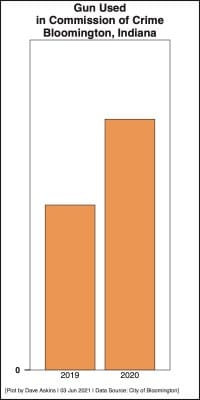Opinion: Bloomington is 52% serious about gun crime

In mid-February, Bloomington’s mayor, John Hamilton, and chief of police, Mike Diekhoff, among others, appeared at a press conference to present the city’s annual public safety report.

The event was framed by Hamilton like this: “By sharing public data about the full range of public safety issues, we embrace accountability, …to identify persistent problems in order to address them transparently.”
One statistic reported in February was that 2020 showed a 52-percent increase, compared to 2019, in the number of cases where a gun was used to perpetrate a crime.
That’s a big jump.
Like other news outlets, The Square Beacon included that percentage figure in its report of the press conference.
Not long after The Square Beacon’s article was published, a reader asked: So what were the actual numbers of gun crimes each year? Long story short: Nobody seems to know.
Of course, the reader’s question was a fair one. It’s a question The Square Beacon should have asked without prodding from a reader.
After a phone call with the police records division, two formal records requests under Indiana’s Access to Public Records Act, and email correspondence that included the legal department, the mayor, the deputy mayor, the city’s communications director, the president of the city council, and the chief of police, all of which stretched over about three months, the reader’s question remains unanswered.
It’s not possible to say what two numbers allowed the calculation of a 52 percent increase “without recreating the original research project,” according to an assistant city attorney.
Why was a “research project” needed to determine the percentage increase in Bloomington gun crimes?
Based on email correspondence from the legal department, it’s because the police department does not routinely maintain data on the number of crimes that involve the use of a gun. And the police department does not maintain lists that track all crimes involving guns.
A Feb. 10 email message from a records clerk to the chief of police, which the city produced in response to one of the records requests, gives the percentage increase, with several other data points. But the message does not name the two crucial numbers that are used to compute the 52.44-percent increase.
It was a Square Beacon attempt on May 10, to clarify and confirm the information in the Feb. 10 email message, that got the response from the city’s legal department saying the numbers could not be produced without recreating the research project.
An earlier response from the records department had included a string of text that was partly reflected in the Feb. 10 email message but included additional text of unclear origin (emphasis added): “52.44% increase in the number of crimes committed with a firearm 125 of the 170 cases reported the use of firearms.”
If 125 was the number of crimes committed with a firearm in Bloomington in 2020, and that was a 52 percent increase, then basic algebra says the number in 2019 was 82. But when asked to confirm that 82 was the number of gun crimes in 2019, the response from police records was: “Unfortunately, we can’t confirm the number. The information provided to you were the only notes accessible for that presentation.”
According to the city’s legal department, for the stats in the Feb. 10 email message to the chief of police, the records analyst “used a combination of keyword-driven computer searches and manual review of investigative reports to determine the number of occurrences in 2019 and 2020 in which a crime involved the use of a gun. These raw tallies were used to calculate the annual figures.”
Is it important to recreate a research project to pin down the numbers of gun crimes in 2019 and 2020? Probably not at this point.
But it is important to reflect on whether this is a statistic worth knowing for Bloomington. In a Square Beacon email message to deputy mayor Don Griffin here’s how the issue was framed:
What is the future of that specific statistic (cases where a gun was used in the commission of a crime) in the city’s analysis? More specifically: Is this a statistic that will be calculated for next year’s public safety report? Will the city start logging crimes where a gun was used as a separate record set, so that it can be added to B Clear Data as a dataset? If this stat does not have a future in the city’s future analysis, why was it calculated this year?
Those questions did not get a response from the deputy mayor.
The Bloomington police department already posts a couple dozen datasets on the B Clear Data portal. From police officer demographics, to data on officer-involved-shootings, to use-of-force data (broken down by race of subject and officer), the B Clear police department datasets count as a credible effort toward what the mayor calls “embracing accountability.”
Undercutting that credible effort is the inability to confirm two numbers that form the basis of a claim about a 52-percent rise in gun crimes.
The claim of a 52-percent rise, unaccompanied by the actual numbers, lands more like a one-off political point, than data that is important for local policing and public safety.
If tracking the number of gun crimes in Bloomington is important, then mayor Hamilton’s administration should commit to publishing a quarterly B Clear dataset on the topic.
That would show that Bloomington is 100-percent serious about gun crime.




Comments ()